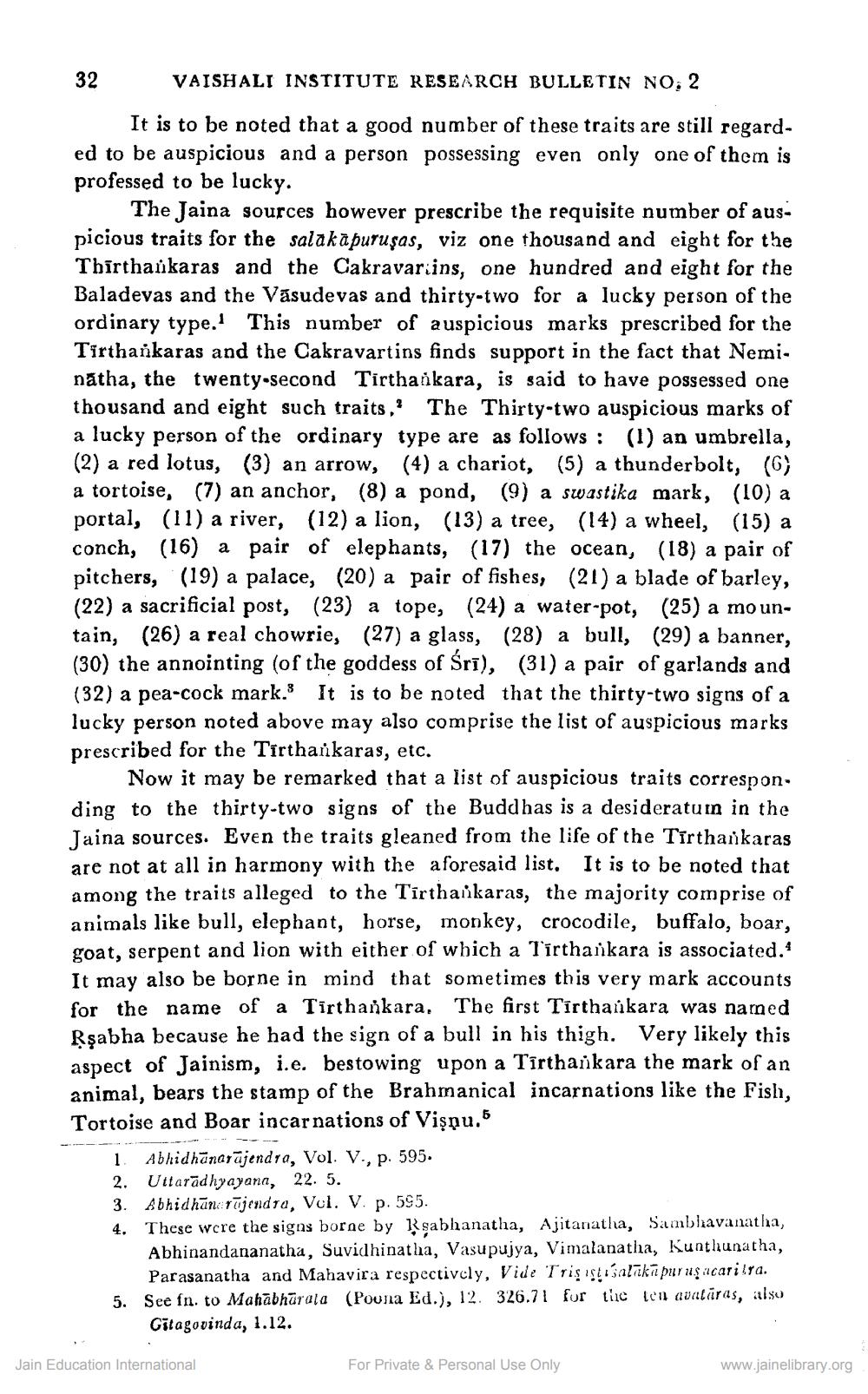________________
32
VAISHALI INSTITUTE RESEARCH BULLETIN NO: 2
It is to be noted that a good number of these traits are still regarded to be auspicious and a person possessing even only one of them is professed to be lucky.
The Jaina sources however prescribe the requisite number of auspicious traits for the salakāpuruşas, viz one thousand and eight for the Thirthařkaras and the Cakravariins, one hundred and eight for the Baladevas and the Vasudevas and thirty-two for a lucky person of the ordinary type. This number of auspicious marks prescribed for the Tirthankaras and the Cakravartins finds support in the fact that Nemi. natha, the twenty-second Tirthankara, is said to have possessed one thousand and eight such traits,' The Thirty-two auspicious marks of a lucky person of the ordinary type are as follows : (1) an umbrella, (2) a red lotus, (3) an arrow, (4) a chariot, (5) a thunderbolt. a tortoise, (7) an anchor, (8) a pond, (9) a swastika mark, (10) a portal, (11) a river, (12) a lion, (13) a tree, (14) a wheel, (15) a conch, (16) a pair of elephants, (17) the ocean, (18) a pair of pitchers, (19) a palace, (20) a pair of fishes, (21) a blade of barley, (22) a sacrificial post, (23) a tope, (24) a water-pot, (25) a mountain, (26) a real chowrie, (27) a glass, (28) a bull, (29) a banner, (30) the annointing (of the goddess of Śrī), (31) a pair of garlands and (32) a pea-cock mark. It is to be noted that the thirty-two signs of a lucky person noted above may also comprise the list of auspicious marks prescribed for the Tirthankaras, etc.
Now it may be remarked that a list of auspicious traits correspon. ding to the thirty-two signs of the Buddhas is a desideratuin in the Taina sources. Even the traits gleaned from the life of the Tirtharkaras are not at all in harmony with the aforesaid list. It is to be noted that among the traits alleged to the Tirthaikaras, the majority comprise of animals like bull, elephant, horse, monkey, crocodile, buffalo, boar, goat, serpent and lion with either of which a Tirthaikara is associated.4 It may also be borne in mind that sometimes this very mark accounts for the name of a Tirthankara. The first Tirthaikara was named Rşabha because he had the sign of a bull in his thigh. Very likely this aspect of Jainism, i.e. bestowing upon a Tīrthankara the mark of an animal, bears the stamp of the Brahmanical incarnations like the Fishi, Tortoise and Boar incarnations of Vispu.
1 Abhidhanarajendra, Vol. V., p. 595. 2. Uttarādhyayana, 22. 5. 3. Abhidhāni rūjendra, Vol. V. p. 595. 4. These were the signs borne by Rsabhanatha, Ajitanatha, Sambhavanatha,
Abhinandananatha, Suvidhinatha, Vasupujya, Vimalanatha, Kunthunatha,
Parasanatha and Mahavira respectively, Vide Trisustusalākā puruşacarilra. 5. See in. to Mahābhūrala (Pouna Ed.), 12. 326.71 for the len avatāras, alsu
Gitagovinda, 1.12.
Jain Education International
For Private & Personal Use Only
www.jainelibrary.org




